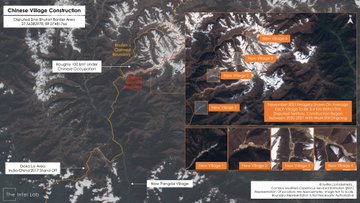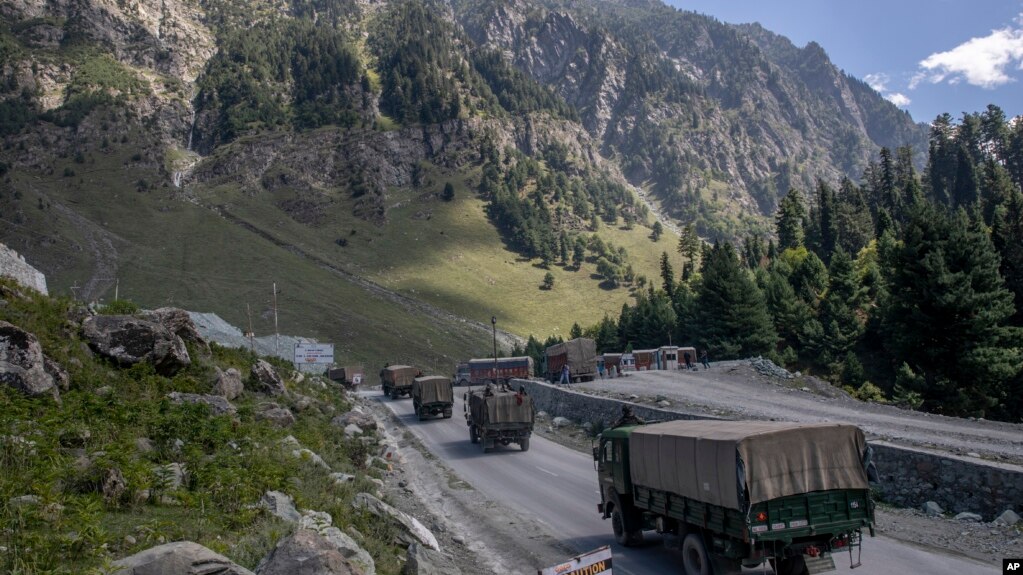Occupation By Stealth
"We are going through a particularly bad patch in our relationship because they have taken a set of actions in violation of agreements for which they still don’t have a credible explanation and that indicates some rethink about where they want to take our relationship, but that’s for them to answer.""I don’t think the Chinese have any doubt on where we stand on our relationship and what’s not gone right with it. I’ve been meeting my counterpart Wang Yi a number of times. As you would’ve experienced, I speak fairly clear, reasonably understandably [and] there is no lack of clarity so if they want to hear it, I am sure they would have heard it."Indian External Affairs Minister S. Jaishankar"Disputed land between #Bhutan & #China near Doklam shows construction activity between 2020-21." "Multiple new villages spread through an area roughly 100 km² now dot the landscape.""Is this part of a new agreement or enforcement of #China's territorial claims?"@detresfa, global researcher, The Intel Lab

"China has undertaken construction activities in the past several years along the border areas, including in the areas that it has illegally occupied over decades.""India has neither accepted such illegal occupation of our territory nor has it accepted the unjustified Chinese claims.""The government is committed to the objective of creating infrastructure along border areas for improvement of livelihood, including in Arunachal Pradesh."India’s External Affairs Ministry spokesperson, Arindam Bagchi
"[The report said that despite ongoing diplomatic and military dialogue to reduce border tensions, China has] continued taking incremental and tactical actions to press its claims at the LAC -- [the Line of Actual Control that divides the two countries].""Sometime in 2020, the PRC built a large 100-home civilian village inside disputed territory between the PRC's Tibet Autonomous Region and India's Arunachal Pradesh state in the eastern sector of the LAC. These and other infrastructure development efforts along the India-China border have been a source of consternation in the Indian government and media."Pentagon annual report: Military and Security Developments Involving the People’s Republic of China"The Chinese are building villages possibly for billeting and locating their civilians or for the military in the future all along the LAC, particularly after the recent face-off that we have had.""China is India’s main adversary and not Pakistan.A lack of 'trust' and growing 'suspicion' is coming in the way of resolving the border dispute between the two countries.""India was stocked up for a 'long winter'."Indian Chief of Defense Staff Bipin Rawat
 |
| An Indian army convoy moves along the Srinagar-Ladakh highway at Gagangeer, northeast of Srinagar, Indian-administered Kashmir. Control over the Ladakh border region is a key friction point between India and China. |
Satellite
imagery shows a village suddenly appearing which did not exist until
2019, one of the buildings in the village with a flag of China painted
on its roof; a novel method of territorial claim. Somewhat reminiscent
of Russia planting a flag undersea in the disputed high Arctic. Several
villages have appeared as though out of nowhere, one with 60 homes
another with 100 in the remote Indian state of Arunachal Pradesh.
Just as it has done in East Turkestan, home to Turkic Muslims, mostly Uyghurs,
but also Kazakhs and Kyrgyz where Beijing has taken steps to thin out
the Uyghur population, sending them elsewhere to work as slave labourers
while sending Han Chinese to live in traditional Uyghur territory.
China's invasion of Tibet and its hardline suppression of Tibetan
culture claiming Tibet as its sovereign territory, also saw Han Chinese
being settled in traditional Tibetan areas of habitation.
Possession,
it believes, is nine-tenths of the natural law of ownership. Depriving
populations of their heritage geography with claims the territory is in
China's possession is a raw adaptation of natural selection by a China
that believes it will inherit the world and the global order as the
world's first super super-power by persistent and relentless
occupation.
A
global researcher with the Intel Lab shared satellite images showing
houses built by China in Dongiang, a disputed area with Bhutan. A
standoff between the Indian and Chinese armies in 2017 is generally
viewed as a prelude to the ongoing border clashes taking place in
Ladakh, where dozens of soldiers died and were injured in skirmishes
again last year. Tensions between India and China along the Line of
Actual Control have arisen, both sides increasing their military
presence.
 |
China
must have the advantage and India must back down as far as Beijing is
concerned. It has also come to light that a Chinese army research
laboratory has been engaged in genetic research with the intention of
aiding soldiers to better operate at high altitudes as Beijing seeks to
pursue military technology. And as is usual with China, it pursues
collaborative efforts with Western sources who have the advantage in
research superiority.
Chinese
military forces have in the past trained with Canadian military in far
north winter survival techniques. China has established a research
relationship at a Danish university where Chinese scientist and citizen
Guojie Zhang wrote a research paper with a senior officer in the
People's Liberation Army focusing on an experiment exposing laboratory
monkeys to extreme altitudes hoping to comprehend the effect of low
oxygen levels at high altitudes on brains.
The
urgency to China of research such as a 2012 genetic research program
into the cause of altitude sickness keys directly into its furtive and
aggressive advances in the Himalaya regions disputed between itself and
India as China seeks to reinforce its military following its Himalayan
border skirmishes with India where oxygen levels on the Tibetan plateau
at an elevation of some 1,650 feet can be 35 percent lower than what
prevails at sea level.
A report published by King's College London and the Harvard Kennedy School of Government in March called for "a full audit of current projects with China"
including safeguards to prevent research becoming dependent on
cross-funding from tuition fees from international students. Danish
universities were warned by Denmark's intelligence agency they could
unwittingly become involved in foreign military research.
 |
| The logo of Chinese gene firm BGI Group is seen at its building in Beijing, China March 25, 2021. PHOTO: REUTERS |
Labels: Border Disputes, China-India Military Confrontations, Himalaya, Stealth Building, Territorial Aggression

<< Home